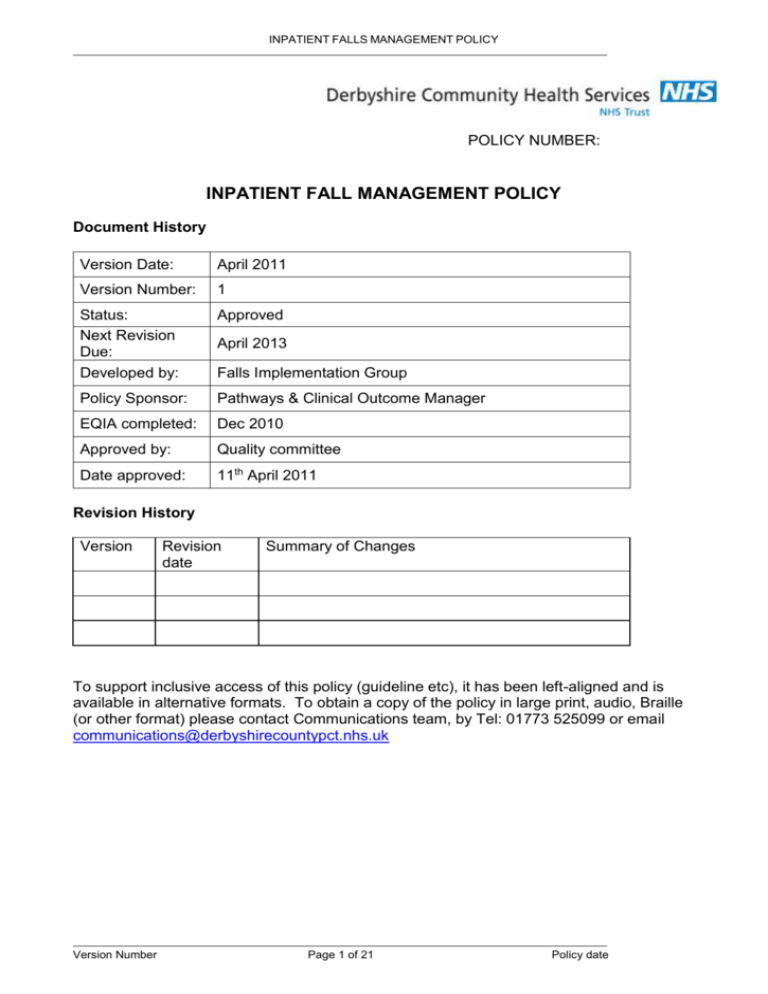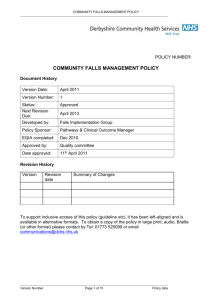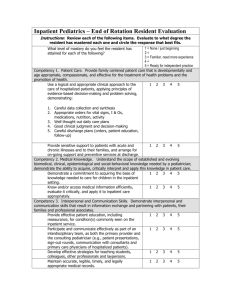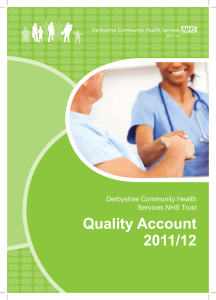DCHS Inpatient falls management policy
advertisement

INPATIENT FALLS MANAGEMENT POLICY POLICY NUMBER: INPATIENT FALL MANAGEMENT POLICY Document History Version Date: April 2011 Version Number: 1 Status: Next Revision Due: Developed by: Approved Policy Sponsor: Pathways & Clinical Outcome Manager EQIA completed: Dec 2010 Approved by: Quality committee Date approved: 11th April 2011 April 2013 Falls Implementation Group Revision History Version Revision date Summary of Changes To support inclusive access of this policy (guideline etc), it has been left-aligned and is available in alternative formats. To obtain a copy of the policy in large print, audio, Braille (or other format) please contact Communications team, by Tel: 01773 525099 or email communications@derbyshirecountypct.nhs.uk Version Number Page 1 of 21 Policy date INPATIENT FALLS MANAGEMENT POLICY TABLE OF CONTENTS 1. FULL DETAIL OF POLICY .......................................................................................... 3 1.1 Hospital Admissions ............................................................................................... 3 1.2 Training and development for falls prevention and management ...................... 4 2. References and Associated Documentation ............................................................ 4 3. Appendices ................................................................................................................. 6 Appendix 1 APPENDIX 2 Falls prevention in hospitals Flow chart................................................. 7 PATIENT FALL FLOW CHART .............................................................. 8 appendix 3 .......................................................................................................................... 9 appendix 4 ........................................................................................................................ 11 appendix 5 ........................................................................................................................ 13 appendix 6 ........................................................................................................................ 15 4. AIM .............................................................................................................................. 17 5. 5.1 6. Background ............................................................................................................... 17 Table - Objectives ................................................................................................ 17 Area for Implementation .......................................................................................... 18 7. Organisational Accountability/Responsibilities i.e. CEO, Directors, Managers, Staff ................................................................................................................................... 18 8. Intended Users .......................................................................................................... 18 9. Definition ................................................................................................................... 19 10. Indications for Use ................................................................................................ 19 11. Contra-indications ................................................................................................ 19 12. Equality Impact Statement ................................................................................... 19 13. Monitoring and Performance Management of the policy .................................. 19 14. Support and Additional Contacts ........................................................................ 20 Equality & Diversity Impact Assessment : Version Number Page 2 of 21 Level I Screening .................................. 21 Policy date INPATIENT FALLS MANAGEMENT POLICY INPATIENT FALLS MANAGEMENT POLICY 1. FULL DETAIL OF POLICY This policy is to assist staff to reduce the risk, incidence and severity of in-patient falls within the Community Hospitals of Derbyshire Community Health Services (DCHS). The policy should be read in conjunction with the policies for The Management and Prevention of Slips, Trips and Falls and the Safe and Effective use of Bedrails in Community Hospitals. Clinical Policies page 1.1 HOSPITAL ADMISSIONS All clinical staff working in DCHS community hospitals must follow the ‘Falls Prevention in Hospitals’ Flow chart (see Appendix 1). 1.1.a Risk Assessment Patients admitted to a DCHS community Hospital require a Falls Risk Assessment completing within 4 hours of admission ‘Risk assessment for the Prevention and Management of Falls’ 1.1.b Treatment Plan A treatment plan reflecting each individual’s falls risk assessment will be generated, identifying the goals, interventions and risks agreed with the patient and their carers if and when appropriate. This should be completed within 24 hours of admission. Please click on the link to access the documentation site for ‘high’ 0310, ‘medium’ 0309 and ‘low’ 0308 treatment plan templates 1.1.c Evaluation and Reassessment The frequency of review of the Falls Risk Assessment must be documented and undertaken (see ‘Risk assessment for the Prevention and management of Falls’). The risk of falls will be reassessed in accordance with each individual’s risk assessment – ‘high’ daily, ‘medium’ – every 4 days and ‘low’ – every 7 days, (therefore at a minimum of every 7 days), or if any changes occur. The treatment plan will be updated following each reassessment of falls risk, (changing to relevant treatment plan if appropriate), and the patient’s records updated. 1.1.d Fall If a patient falls or a fall related near miss occurs, the ‘Patient Fall Flow Chart’ will be followed and actioned, see Appendix 2. IF A SEVERE INJURY IS EVIDENT OR SUSPECTED DIAL 9 999 FOR TRANSFER TO ACUTE SERVICES. All incidents must be reported including patient details, time, location and circumstances of the falls, and details of any injury or if non apparent, by completing an Incident Form. Version Number Page 3 of 21 Policy date INPATIENT FALLS MANAGEMENT POLICY All incidents which have level 3 or 4 harm will be evaluated using root cause analysis by the Patient Safety Team. 1.1.e Discharge to Own Home Patients at risk of falls at home needs to be established. Refer to Community Falls Management Policy Section 1.1a, 1.1b screening and risk assessment tools. Referrals onto community or day service based specialist falls services for specialist falls interventions will be made if indicated. 1.1.f Discharge to Care Home Patients at risk of falls in care home settings need to be established. Refer to Community Falls Management Policy Section 1.1a, 1.1b screening and risk assessment tools. Referral onto community falls service will be made if indicated by multi-disciplinary team. 1.2 TRAINING AND DEVELOPMENT FOR FALLS PREVENTION AND MANAGEMENT Within DCHS there will be 3 levels of training for falls prevention and management: Level 1 - ALL DCHS staff regardless of location, should have basic awareness training in relation to falls prevention and their roles and responsibilities therein. This will include an understanding of the potential causes of falls including intrinsic and extrinsic factors. All DCHS staff assessing patients, again regardless of location, will be made aware of and trained in the use of the relevant falls prevention and management tools and associated processes. They will also undertake further fall prevention and management training on areas relevant to their profession. All Level 1 staff will access the Falls Training DVD and line managers must keep a record of the staff who have undertaken this training and forward the details to the Learning Team to ensure the electronic staff record (ESR) is updated. Falls Awareness and Prevention will be included in essential training, all new staff induction and preceptorship competency frameworks. Level 2 - All wards/ departments should have an identified ‘Falls Champion’ who will be expected to lead and ensure the process is in line with the policy and to lead the local scrutiny of monthly falls reports. Identified champions and other key clinical leaders will receive training on the falls policy, risk assessments decision algorithms. Level 3 - All staff providing a specialist falls service or performing specialist falls assessments will require evidence based training and skills updating. This training will require individuals to access ‘learning beyond registration’ funding to apply for accredited courses delivered by external providers. 2. REFERENCES AND ASSOCIATED DOCUMENTATION DCHS Management and Prevention of Slips, Trips and Falls Policy DCHS Record Keeping Policy Version Number Page 4 of 21 Policy date INPATIENT FALLS MANAGEMENT POLICY DCHS Incident reporting Policy DCHS Joint Derby and Derbyshire Health & Social Care Policy for the Safe Use of Bed Rails in the Community. DCHS Policy for the Safe and Effective Use of Bed Rails within the Community Hospital Do Once Share Pathway web site accessed November 2010: http://www.connectingforhealth.nhs.uk/resources/systserv/do-onceand/?searchterm=do%20once%20and%20share Fonda D et al. (2006) Reducing serious fall related injuries in hospital. Medical Journal of Australia 184: 379-382 Haines TP et al (2004) Effectiveness of targeted falls prevention programmes in a sub acute setting. A randomised controlled trial. British Medical Journal 328: 676-679 Healey F et al. (2004) Using targeted risk factor reduction to prevent falls in older hospital inpatients A randomised controlled trial Age and Ageing 33: 390-395 Help the aged (2008) Falling Short Help the Aged London NHS Institute for Innovation and Improvement (2009) High Impact actions for Nursing and Midwifery http://www.institute.nhs.uk/images/stories/Building_Capability/HIA/NHSI%20High%20Impa ct%20Actions.pdf National Institute for Health and Clinical Excellence (2004) Falls-The assessment and prevention of falls in older people. Available at: www.nice.org.uk/guidance/CG21/guidance/pdf/English Department of Health (2001) National Service Framework for Older People Medicines and Healthcare products Regulatory Agency Device Alert 2007/001. Reporting Medical Device Adverse Incidents and Disseminating Medical Device Alerts. Available at: www.mhra.gov.uk Oliver D et al. (2005) Prevention of falls in hospitals and care homes and in persons in those settings with cognitive impairment or dementia. Department of Health Accidental Injury Prevention Programme Oliver D et al. (1997) Development and evaluation of evidence based risk assessment tool (STRATIFY) to predict which elderly inpatients will fall: case-control and cohort studies. British Medical Journal 315: 1049-1053. Available at: www.bmj.com/cgi/content/full/315/7115/1049 Oliver D et al. (2004) Risk factors and risk assessment tools for falls in hospital inpatients: a systematic review. Age and Ageing. 33: 122-130 The Patient Safety First Campaign have recently issued a ‘How to’ Guide for reducing harm from falls. http://www.patientsafetyfirst.nhs.uk/ashx/Asset.ashx?path=/Interventionsupport/FALLSHow-to%20Guide%20v4.pdf Version Number Page 5 of 21 Policy date INPATIENT FALLS MANAGEMENT POLICY Prevention Package for Older People http://www.dh.gov.uk/en/SocialCare/Deliveringadultsocialcare/Olderpeople/Preventionpack age/index.htm http://www.dh.gov.uk/prod_consum_dh/groups/dh_digitalassets/@dh/@en/@pg/document s/digitalasset/dh_103152.pdf http://www.dh.gov.uk/prod_consum_dh/groups/dh_digitalassets/@dh/@en/@pg/document s/digitalasset/dh_103151.pdf http://www.dh.gov.uk/prod_consum_dh/groups/dh_digitalassets/@dh/@en/@pg/document s/digitalasset/dh_103147.pdf Royal College of Physicians (2008) National Falls and Bone Health in Older People accessible via (Accessed 9th November 09). 3. APPENDICES Appendix 1 – Falls Prevention in Hospital Flow chart Appendix 2 – In-Patient Fall Flow Chart Appendix 3 - Risk Assessment for the Prevention and Management of Falls Appendix 4 – Falls High Risk Treatment Plan Appendix 5 – Falls Low Risk Treatment Plan Appendix 6 – Falls Medium Risk Treatment Plan Version Number Page 6 of 21 Policy date INPATIENT FALLS MANAGEMENT POLICY Appendix 1 Falls prevention in hospitals Flow chart Patient Admitted ASSESS & IDENTIFY RISKS ASSESS & IDENTIFY RISKS MANAGEMENT Falls assessment to be completed to identify risk factors Patient Specific (Intrinsic) ●Cognition & behaviours ●Mobility and transfer skills ●Incontinence ●Medical conditions ●Medication review ●Vision/hearing ●Footwear & clothing Environmental (Extrinsic) ●Lighting ●Bed height ●Room free of clutter ●Mobility aids ●Call bell ●Route to toilet/commode clear Is patient able to engage in joint planning of preventative strategies? NO those with cognitive impairment or dementia) YES (includes STRATEGIES ● Increase Observation. ● Move patient close to nurses station. ● Supervise mobilisation and toileting. ●Assessment of behaviours STRATEGIES ● Medication review, avoid sedatives, hypnotics. Regular toileting plan. Orientation to ward. Call bell within easy reach. Ultra low beds/bed at lowest height and brakes on. Night lights Mobility aids check. Glasses and hearing aids within easy reach. Use of non-slip footwear and mats/flooring. Area clear of hazards. Use of alarm devices. Referral to therapists. Involve family – education and care about the seriousness of falls. Provide patient with information about falls Complete Treatment Plan REASSESS POST FALL DISCHARGE Version Number Reassess risk according to assessment, (‘high’ - daily, ‘medium’ – 4 days, ‘low’ 7 days), or if any changes occur. Review/adjust management plan, and update documentation. Patient – See best practice guide, Reassess, implement, document and communicate to staff post fall assessment and management plan. Health and Safety - Complete incident form, review environment and manage risk. Onward referral to Therapy Teams in your area if risk of falls in community is identified Page 7 of 21 Policy date INPATIENT FALLS MANAGEMENT POLICY APPENDIX 2 PATIENT FALL FLOW CHART Patient Fall Flow Chart Check for signs of physical injury No significant signs of Injury Deformity of limbs Loss of sensation to limbs Pain Bleeding Head injury ● Return patient to bed/chair using appropriate moving and handling technique and equipment. ● Record neurological observations if there is a head injury or UNWITNESSED FALL ● Record baseline observations using early warning score chart if NO head injury. ● Assess for pain and administer pain relief as prescribed - Patients with head injury should not receive systemic analgesia until fully assessed so that an accurate measure of consciousness and other neurological signs can be made. ● Repeat Neurological observations after 2 hours. If stable repeat after 4 hours then daily. If Glasgow Coma Scale (GCS) is 15 revert to daily observations unless clinical signs of deterioration. Re-check for signs of physical injury Swelling Pain Bruising Loss of sensation Deformity of limbs Signs of significant injury Dial 999 for ambulance Do not move patient Administer first aid to any bleeding points Record neurological observations Keep patient comfortable Keep patient Nil By Mouth ● Repeat Neurological observations: Half-hourly for 2 hours Then 1-hourly for 4 hours or until the ambulance arrives. If GCS is below 15 neurological observations should be recorded every 30mins ● Complete SBAR Urgent Transfer Form ● Consider pain relief, pressure area care and fluid intake ● Inform practitioner responsible for the patients care at the next review or earlier if condition indicates. Further investigations may be requested to determine cause of fall. ● If fall occurs out of hours inform the responsible practitioner next working day or contact out of hours service. MIU can be accessed if required. ● Inform next of kin ● Review and re-assess Patient records, refer to Patient Falls Management Policy and Slips Trips & Falls Policy. ● Initiate falls (re)Assessment and treatment plan. ● Complete Incident Form Version Number Page 8 of 21 Contact next of kin Ensure patient records are completed Complete Incident Form Policy date INPATIENT FALLS MANAGEMENT POLICY APPENDIX 3 SURNAME NHS No ___/___/____ HOSPITAL FORENAME MALE / FEMALE WARD ADDRESS D.O.B GP/Consultant RISK ASSESSMENT FOR THE PREVENTION & MANAGEMENT OF FALLS Date of Admission: _ _ / _ _ / _ _ _ _ Barthel Transfer Score Date Patient unable to transfer/immobile Major help needed (one/two people, physical aids) 0 Minor Help Needed (verbal or physical) 2 Independent 3 1 Barthel Mobility Score 0 Patient immobile Independent with the aid of a wheelchair 1 Walks with help from one person 2 Independent 3 Total Adapted from STRATIFY: 1 Is the patient aged 65 years or over? Did the patient present at hospital with 2 a fall? Or has the patient fallen on the ward since admission? 3 Is the patient agitated or confused? Version Number Yes = 1 No = 0 Yes 1 No 0 Yes 1 No 0 Page 9 of 21 = = = = Policy date INPATIENT FALLS MANAGEMENT POLICY Is the patient visually impaired to the 4 extent that every day function is affected? Has the patient a combined Barthel 5 mobility and transfer score >3 Yes 1 No 0 Yes 1 No 0 = = = = TOTAL Signature: RISK ASSESSMENT Low Risk 0-1 Date & Time Medium Risk 2 High Risk > or = 3 COMPLETE SCREENING PLAN FOR ALL PATIENTS © Copyright 2009 Quality & Integrated Governance Team, Derbyshire Community Health Services Version Number Page 10 of 21 Policy date INPATIENT FALLS MANAGEMENT POLICY APPENDIX 4 SURNAME NHS No ___/___/___ _ HOSPITAL FORENAME MALE / FEMALE ADDRESS D.O.B WARD GP/Consulta nt FALLS HIGH RISK TREATMENT PLAN Date &Time Problem No Problem / Need Initials Stop Date …………………………. has been assessed under the DCHS falls risk assessment and is at HIGH risk of falls. Date/ Time Goals Agreed With Patient Initials To minimise the risk of falling. Version Number Page 11 of 21 Policy date Achieved Yes (Y) Date No (N) /Time & Initial INPATIENT FALLS MANAGEMENT POLICY Treatment Plan Has the person got capacity to consent to this Treatment Plan? Yes □ No □ If “No” complete Capacity Assessment Consent obtained? Yes □ No □ If “No” document reason/action ……………………………………… Date and Time Treatment to be Performed By Treatment Plan Considering any cognitive impairment will have an impact upon calling for assistance ensure the nurse call bell is in reach and implement additional strategies as required to minimise the risk of falling Considering any cognitive impairment will have an impact to orientation around the bed area /ward Highlight the layout of the ward including toilet areas to patients who may require to use the toilet more urgently. Implement additional strategies as required to minimise the risk of falling Ensure that personal effects (e.g. glasses, hearing aids etc) including mobility aids are within easy reach and that the environment is not cluttered. Is ……………………in the best location on the ward in relation to visual observation from the staff base Record postural blood pressure and report any abnormalities to appropriate clinician. Assess, plan and document management of night time activity. Report to appropriate Clinician to review all medication if more than 4 prescribed. Date requested …………………………………………. Consider nursing on a high/low bed at its lowest level with crash mat at the side Consider 1:1 nursing or request family assistance Consider use of sensor alarms if available to bed and/or chair Required yes / no Please circle Date applied …………………………………………………….. Check footwear is correctly fitted and if not inform relatives Date informed …………………………………… Ensure Manual handling plan is up to date MDT review Has the level of risk changed ? If no continue ,if yes complete a new risk assessment and plan Discharge . Is follow up required Yes / No (please circle) Document any actions taken Other actions to be considered Treatment Plan to be evaluated/reviewed minimum weekly or as changes occur Version Number Page 12 of 21 Policy date Initials of Prescriber INPATIENT FALLS MANAGEMENT POLICY APPENDIX 5 SURNAME NHS No ___/___/___ _ HOSPITAL FORENAME MALE / FEMALE ADDRESS D.O.B WARD GP/Consulta nt FALLS LOW RISK TREATMENT PLAN Date &Time Problem No Initials Problem / Need Stop Date …………………………….. has been assessed via the DCHS falls risk assessment and is at LOW RISK of falls. Date/ Time Goals Agreed With Patient Initials To minimise the risk of falling. Version Number Page 13 of 21 Policy date Achieved Yes (Y) Date No (N) /Time & Initial INPATIENT FALLS MANAGEMENT POLICY Treatment Plan Has the person got capacity to consent to this Treatment Plan? Yes □ No □ If “No” complete Capacity Assessment Consent obtained Yes □ No □ If “No” document reason/action …………………………………….…… Date and Time Treatment to be Performed By Treatment Plan Considering any impairment if present, to cognition ensure the nurse call buzzer is in reach and………………………….can understand how to use it.. Considering any impairment if present to cognition, ensure orientation to the ward and its layout Highlight the toilet areas to patients who may require access more urgently Ensure that personal effects (e.g. glasses, hearing aids etc) including mobility aids are within easy reach and the environment is not cluttered. Report to appropriate Clinician to review medication if more that 4 medications prescribed Date requested……………………………………………………… Check footwear is correctly fitted and if not inform relatives Date informed (applicable)……………………………………………. MDT review – Has level of risk changed? If no continue, if yes complete a new risk assessment and plan. Ensure Manual Handling plan is up-to-date. Any other actions to be considered Treatment Plan to be evaluated/reviewed minimum weekly or as changes occur Version Number Page 14 of 21 Policy date Initials of Prescriber INPATIENT FALLS MANAGEMENT POLICY APPENDIX 6 SURNAME NHS No ___/___/___ _ HOSPITAL FORENAME MALE / FEMALE ADDRESS D.O.B WARD GP/Consulta nt FALLS MEDIUM RISK TREATMENT PLAN Date &Time Problem No Initials Problem / Need Stop Date ………………………. has been assessed under the DCHS falls risk assessment tool and is at MEDIUM risk of falls. Date/ Time Goals Agreed With Patient Initials To minimise the risk of falling. Version Number Page 15 of 21 Policy date Achieved Yes (Y) Date No /Time & (N) Initial INPATIENT FALLS MANAGEMENT POLICY Treatment Plan Has the person got capacity to consent to this Treatment Plan? Yes □ No □ If “No” complete Capacity Assessment Consent obtained? Yes □ No □ If “No” document reason/action ……………………………………… Date and Time Treatment to be Performed By Treatment Plan Considering any cognitive impairment will have an impact upon calling for assistance, ensure the nurse call buzzer is in reach and implement additional strategies as required to decrease risk of falling. Considering any cognitive impairment will have an impact to orientation around the bed area/ward. Highlight the layout of the ward including toilet areas to patients who may require to use the toilet more urgently. Implement additional strategies as required to decrease risk of falling. Ensure that personal effects (e.g. glasses, hearing aids etc) including mobility aids are within easy reach and that the environment is not cluttered. Is ………….. …in the best location on the ward in relation to visual observation from the staff base Record postural blood pressure and report any abnormalities to the appropriate clinician. Assess, plan and document night time activity. Report to appropriate Clinician to review all medication if more than 4 prescribed. Date requested ……………………………………………….. Check footwear is correctly fitted and if not inform relatives Date informed (if applicable) ………………………………… Ensure Manual Handling Plan is up to date MDT review – Has the level of risk changed ? If no continue ,if yes complete a new risk assessment and plan Discharge – Is follow up required Yes /No (please circle) Document any follow up actions Other actions to be considered Treatment Plan to be evaluated/reviewed minimum weekly or as changes occur Version Number Page 16 of 21 Policy date Initials of Prescriber INPATIENT FALLS MANAGEMENT POLICY 4. AIM The aim of this Policy is to manage the risk of, and reduce the incidence of, and thereby reducing the harm from; older people experiencing falls in DCHS Community Hospitals. The Policy provides a framework with quality standards to: identify people who have fallen and or who are at risk of falling again assess the level of risk for individuals generate, implement and evaluate appropriate treatment plans identify the need and scope for and of a specialist falls intervention. There is an expectation that clinicians will use the framework within everyday practice within DCHS. It recognises that falls are a multi-dimensional problem which requires a partnership approach across the localities and between health, social care and voluntary organisations. DCHS will deliver a service/pathway which will be based upon evidence-based practice as stated in key national guidelines (NICE). Our services will use, as part of the framework, validated tools to support the assessment and treatment process. 5. BACKGROUND A patient falling is the most common patient safety incident reported to the National Reporting and Learning Service (NRLS) from inpatient services. Over 200,000 falls were reported to the Reporting and Learning System (RLS) in the 12 months from September 2005 to August 2006, with reports of falls coming from 98 per cent of organisations that provide inpatient services. Historically the National Service Framework, gave organisations key guidance in the identification and treatment for patients who have fallen. NICE guideline CG21 “Falls: the assessment and prevention of falls in older people” was issued in 2004 to provide guidance on key areas of risk, assessment, interventions, participation and education for the health care community. The Department of Health (DH) issued the Prevention Package for Older People which builds on the National Service Framework and NICE guidance. The Falls and Fractures, effective interventions in health and social care package outlines four key objectives shown in Table 1.0 (July 2009). 5.1 TABLE - OBJECTIVES See below Table 1.0 Objectives - Effective Interventions in Health and Social Care for Falls and Fractures 1. Improve patient outcomes and improve efficiency of care after hip fractures through compliance with core standards. 2. Respond to a first fracture and prevent the second – through fracture liaison services in acute and primary care settings. Version Number Page 17 of 21 Policy date INPATIENT FALLS MANAGEMENT POLICY 3. Early intervention to restore independence – through falls care pathways, linking acute and urgent care services to secondary prevention of further falls and injuries 4. Prevent frailty, promote bone health and reduce accidents – through encouraging physical activity and healthy lifestyle, and reducing unnecessary environmental hazards. In order for DCHS to meet the above objective and NICE guideline, the Falls framework and quality standards will be implemented. 6. AREA FOR IMPLEMENTATION All DCHS Community Hospitals. 7. ORGANISATIONAL ACCOUNTABILITY/RESPONSIBILITIES I.E. CEO, DIRECTORS, MANAGERS, STAFF This section to set out who holds organisational accountability and responsibility for the policy. The Chief Executive holds overall accountability and is responsible for assuring that there are effective systems in place to implement the guidance. The Director of Service Delivery is the lead operational officer for Derbyshire Community Health Services and is accountable to the Managing Director. The Director of Nursing and Quality is accountable for the quality and delivery of care. Operational Managers have responsibility for managing staff groups, risk management, clinical incidents, and competency practice issues once identified. Records of attendance on training will be kept by the Trust. Patient records will be audited to monitor compliance with policy. Staff competency will be evaluated during PDR process. Professionally Registered Staff. All staff are accountable for their professional practice and hold individual responsibility to maintain their knowledge and skills in relation to falls management. It is their responsibility to identify training needs and plan to meet learning objectives identified in their PDR. The policy sponsor is David Muir, Chair of Falls Implementation Group, Pathways & Clinical Outcome Manager and is responsible for ensuring that: - The Policy is developed in line with the DCHS Policy Development Framework; The Policy is disseminated to its target audience; Appropriate training is given in the use of the Policy; The Policy’s implementation is monitored and reviewed on a regular basis. 8. INTENDED USERS All clinical staff working for DCHS in an In-Patient setting. Version Number Page 18 of 21 Policy date INPATIENT FALLS MANAGEMENT POLICY 9. DEFINITION Fall: An event which results in a person coming to rest at a lower level. Explained Fall: We know and understand the reasons that have contributed to falls. Intrinsic: Medical, psychological or physiological reasons for falls. Extrinsic: Environmental reasons for falls. Unexplained Fall: We do not understand the reasons that have contributed to falls history. To presume these are more likely to have medical factors influencing i.e. history of falls Multi-professional: Multidisciplinary approach to falls prevention involving medical, nursing and therapy assessments. 10. INDICATIONS FOR USE All patients admitted to DCHS Community Hospitals. 11. CONTRA-INDICATIONS None. 12. EQUALITY IMPACT STATEMENT We welcome feedback on this policy and the way it operates. We are interested to know of any possible or actual adverse impact that this policy may have on any groups in respect of gender or marital status, race, disability, sexual orientation, religion or belief, age, deprivation or other characteristics. This Policy has been screened to determine equality relevance for the following equality groups: Race, Gender, Disability, Age, Sexual Orientation, Religion/Belief, Transgender/ Transsexual. The Policy is considered to have little or no equality relevance. The person(s) responsible for equality impact assessment for this policy is: Edwina Layton. Tel: 01246 515151 13. MONITORING AND PERFORMANCE MANAGEMENT OF THE POLICY To measure compliance to the Policy an annual audit will be developed and completed. This audit will be both of process and record keeping, but also of the quality and impact Of risk assessments and action plans The findings of the audits and action plans will be reported and monitored by the Falls Implementation Group, (FIG). Exceptions will be reported by FIG to the Safety Committee Version Number Page 19 of 21 Policy date INPATIENT FALLS MANAGEMENT POLICY and to the Service Delivery Directorate’s Governance Group. The falls implementation group will define, develop and implement an implementation strategy across the county. Monitoring of the Guideline will take place via Falls Implementation Group. Audit of number of clinical incidents arising from falls. Analysis of data demonstrating uptake of falls training. Complaints with regard to receiving falls service. Review of Guidelines initially after two years or earlier if new national guidance is released 14. SUPPORT AND ADDITIONAL CONTACTS Name David Muir Jennifer Harrison Joanna Sills Title Chair of Falls Implementation Group Matron and In-patient Lead Integrated Manager Base Babington Hospital Ilkeston Comm Hospital St Oswald’s Hospital Walton Hospital Adelle Clements Patient Safety Manager Peter Sloan Older Peoples Mental Health Newholme Liaison and Practice Development nurse Occupational Ash Green Therapist/Occupational Therapy Team Leader – Learning Disabilities General Manager Walton Hospital Nancy Abbotts Edwina Layton Version Number Page 20 of 21 Contact Number Telephone: 01773 525074 0115 9305522 Telephone: 01335 340806 Telephone: 01246 515814, Mobile: 07824 624452 Telephone: 01629 817945 Telephone: 01629 532317 Mobile: 07881850226 Policy date INPATIENT FALLS MANAGEMENT POLICY EQUALITY & DIVERSITY IMPACT ASSESSMENT : Race Which of the following diversity profiles could suffer detriment as a result of this policy / procedure /process? Religion/Belief What is the purpose of the policy under assessment? What is the background to the policy? (e.g. in response to a statutory requirement, development of good practice, organisational review etc..) Who is intended to benefit from the proposed policy? Is there any potential for impact on non-beneficiaries? Is there up to date data on the groups/individuals on whom there may be impact? Have there been changes to the equalities profile of the above groups/individuals since the collection of the data? Does the policy influence in a positive way relations between different groups of people? LEVEL I SCREENING Gender Disability Age Sexual Orientation Transgender/ ALL GROUPS Transsexual The purpose of the policy is to screen, risk assess and treat patients who are at risk of falls living in the community or hospital. The back ground of the policy is to develop benchmark good practice against national guidelines. All patients who is at risk of or fears falling. The policy is for patients that are identified as at risk of falls or who fall whilst under the care of DCHS there is no impact on non-beneficiaries. This policy will impact upon patients being treated by DCHS and the implementation of a screening, risk assessment and treatment process to support the identification of those at risk of falls. Data on patients who have fallen whilst under the care of DCHS can be obtained from Datix. No It aims to be inclusive for those who are at risk of falls. It forms part of the falls pathway from identifying to specialist assessment / treatment. It gives the opportunity for screening, risk assessment and specialist Does it promote equality of opportunity? assessment for patients within DCHS relating to falls. Does the function either eliminate or contribute to the Although policy is biased towards older people, the policy recognises there elimination of unlawful; discrimination across all equalities are other patient groups in the community who may be at risk of falls due to themes? acute or long term conditions. The policy also links closely with the bed rails and in-patient policies. Are there any concerns expressed about the policy having No the potential for adverse impact on any group/s of people? Assessment Outcomes High No further action Required level 2 assessment by Dec 2012 Level 1 assessment – signing off date: Dec 2010 Version Number Page 21 of 21 Assessment carried out by: Edwina Layton Policy date







